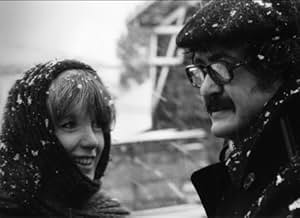Añade un argumento en tu idiomaPierre and Paul, journalist and writer respectively, team up to write a screenplay based on the real story of a young woman accused by her uncle of trying to kill him. They decide to meet he... Leer todoPierre and Paul, journalist and writer respectively, team up to write a screenplay based on the real story of a young woman accused by her uncle of trying to kill him. They decide to meet her.Pierre and Paul, journalist and writer respectively, team up to write a screenplay based on the real story of a young woman accused by her uncle of trying to kill him. They decide to meet her.
- Premios
- 1 premio y 2 nominaciones en total
Marblum Jequier
- Lydie - la femme de Paul
- (as Marblum Jéquier)
Argumento
¿Sabías que...?
- CuriosidadesAlain Tanner names Paul almost all of his male heroes. They are the director's alter ego.
- ConexionesFeatured in Garçon stupide (2004)
Reseña destacada
Most people see in Alain Tanner's movie "La Salamandre" a grotesque critique on everyday's life in Switzerland at the beginning of the 70ies. We see Tanner's films populated with the typical bearded men with their dark Pasolini-eyeglasses and their long shaggy hair. One wonders why they seem to attract rather good-looking girls in hippie-skirts and Moses-sandals ... . That must have been a time when someone's political conviction, marked on the outside, appeared sexy ... .
However, besides the occurrence of an officer for "good Swiss behavior" (a predecessor of the characters Max Bodmer and Moritz Fischer in Rolf Lyssy's legendary Swiss movie "The Swissmakers" (1978)), the plot of Tanner's "Salamandre" goes like that: A journalist and a writer get money for writing a scenario about Rosemonde, a young girl who supposedly killed her uncle. They decide to approach their task from to different sides: The one wants to meet Rosemonde and interview her in order to get the "facts". The other relies wholly on his fantasy in turning the facts into a story. The one is convinced that in order to write somebody's biography one has just to learn to know this person. The other thinks that the bare facts say nothing about a person, and only by aid of sensing what is between the facts, it is possible to draw someone's personality. Hence, both have to come to the conclusion, that neither way is sufficient, or even false, since it seems to be impossible on logical reasons to reconstruct a character - even of a living person. In the case of Citizen Kane, there was only reconstruction left. In the case of "Citoyenne Rosemonde", even description is failing, because she behaves like a salamander, negating her appearance in the moment when she shows it. And obviously, she loves that, despite her alleged naivety, she winds herself out of every possible angle with most elegant cleverness. So, this is in first line a movie about the impossibility to represent the objects or fact by signs. (In Tanner's hitherto last movie, a professor of semiotics disappears, leaving confusing traces to his students.) Traces are by definition ambivalent, and neither logical nor intuitive approaches are sufficient to reconstruct that person that left them - because none of these methods is semiotic and thus appropriate to the traces that are signs. But let us not forget: Although the two writers fail in reconstructing Rosemonde from her traces and signs - does this mean that she is for us, too, non-reconstructible? After all, we have witnessed her over two hours and a lot longer in psychological time. So, Tanner perhaps means that not the protagonists of the film, but the film itself may be appropriate to reconstruct the "real" Rosemonde - since the film is a semiotic medium.
However, besides the occurrence of an officer for "good Swiss behavior" (a predecessor of the characters Max Bodmer and Moritz Fischer in Rolf Lyssy's legendary Swiss movie "The Swissmakers" (1978)), the plot of Tanner's "Salamandre" goes like that: A journalist and a writer get money for writing a scenario about Rosemonde, a young girl who supposedly killed her uncle. They decide to approach their task from to different sides: The one wants to meet Rosemonde and interview her in order to get the "facts". The other relies wholly on his fantasy in turning the facts into a story. The one is convinced that in order to write somebody's biography one has just to learn to know this person. The other thinks that the bare facts say nothing about a person, and only by aid of sensing what is between the facts, it is possible to draw someone's personality. Hence, both have to come to the conclusion, that neither way is sufficient, or even false, since it seems to be impossible on logical reasons to reconstruct a character - even of a living person. In the case of Citizen Kane, there was only reconstruction left. In the case of "Citoyenne Rosemonde", even description is failing, because she behaves like a salamander, negating her appearance in the moment when she shows it. And obviously, she loves that, despite her alleged naivety, she winds herself out of every possible angle with most elegant cleverness. So, this is in first line a movie about the impossibility to represent the objects or fact by signs. (In Tanner's hitherto last movie, a professor of semiotics disappears, leaving confusing traces to his students.) Traces are by definition ambivalent, and neither logical nor intuitive approaches are sufficient to reconstruct that person that left them - because none of these methods is semiotic and thus appropriate to the traces that are signs. But let us not forget: Although the two writers fail in reconstructing Rosemonde from her traces and signs - does this mean that she is for us, too, non-reconstructible? After all, we have witnessed her over two hours and a lot longer in psychological time. So, Tanner perhaps means that not the protagonists of the film, but the film itself may be appropriate to reconstruct the "real" Rosemonde - since the film is a semiotic medium.
- hasosch
- 16 abr 2009
- Enlace permanente
Selecciones populares
Inicia sesión para calificar y añadir a tu lista para recibir recomendaciones personalizadas
- How long is The Salamander?Con tecnología de Alexa
Detalles
- Fecha de lanzamiento
- Países de origen
- Sitios oficiales
- Idioma
- Títulos en diferentes países
- The Salamander
- Localizaciones del rodaje
- Geneva, Canton de Genève, Suiza(setting of the action except for the threesome's outing to Rosemonde's parents'place)
- Empresas productoras
- Ver más compañías en los créditos en IMDbPro
- Duración2 horas 4 minutos
- Color
- Mezcla de sonido
- Relación de aspecto
- 1.66 : 1
Contribuir a esta página
Sugerir un cambio o añadir el contenido que falta

Principal laguna de datos
By what name was La salamandra (1971) officially released in Canada in English?
Responde
![Ver Bande-annonce [OV]](https://m.media-amazon.com/images/M/MV5BYjljZWM0NGQtYjRmMC00YTE2LWJiODMtMTAzOWIzNDQ5MDU3XkEyXkFqcGdeQXRyYW5zY29kZS13b3JrZmxvdw@@._V1_QL75_UX500_CR0)




















